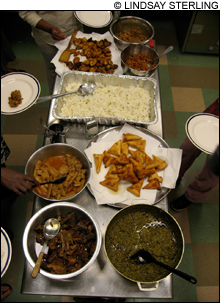
AT THE CLASS An overhead view of a busy kitchen counter. |
In my car are a 62-year-old mother from Congo, her 27-year-old daughter, and their 18-year-old friend from Rwanda. I’m nervous and excited. I’m about to teach a cooking class about food that I don’t know how to cook. I’m presenting the three African ladies to show us all how to do it. I’m in charge of the class, but I’m just basically the driver here. Ten students are all forking over $35 for an Immigrant Kitchens adventure called “A Congolese Feast” six hours from right now. Calm down, I tell my inner control freak. You know this: Constance can cook. And that’s what’s important.
As we drive to markets for ingredients, strings of English, Swahili, Rwandan, French, and Congolese zip around like insects inside the car for a moment and then out the window. When a native Rwandan language is spoken, only two can speak and surprisingly, the daughter doesn’t understand her own mother. When Swahili is spoken, two of us have no idea what’s being said. When French is spoken, three can’t speak. The daughter is crucial. She is the only one who can tell me where to drive the car to get what we need.
At Mittapheap World Market on Washington Avenue (across from Tu Casa), the cart gets loaded up. Five giant stalks of fresh ginger root? How on earth are we going to use all that? TBD. The daughter tells me about the tall bottle of bright red oil she’s holding. It’s called palm oil, made from crushing and boiling the seeds from the fruit of a particular type of palm tree. This has nothing to do with coconuts. The picture on the label shows hundreds of small red fruits growing on a thick stalk. We look for fresh cassava leaves, but there are none today, so Constance (the mother) will use her private stash from her freezer. The rest of the ingredients I have seen before: five bunches of scallions, one eggplant, a couple of garlic heads, raw peanuts, plantains, green bananas, and some dried beans.
Next, we walk down the street to Portland Halal Market, but it’s closed. We’re all unaware that this is the last day of Ramadan. “Now where are we going to get the goat?” I try not to panic. Any number of places, the women say, like goat is as ubiquitous as hamburger meat. I suggest Hamdi, a market and restaurant a couple doors down, where I’d eaten goat once. I’m surprised the women didn’t know of it — because it’s an African store and they’re African. Hamdi, we learn, is a Somalian joint. I think my little assumption was as gross as someone assuming that because I’m from the United States, I know a lot about Mexico. The Congolese daughter asks in English: “Do you have goat?”
“Cooked?” The cook there asks. “No, raw.” He doesn’t know this word, “raw.” Constance and the guy working the register discover they both know Swahili, and soon he cries, “Ah! Meat of goat! Meat of goat!” And he pulls out of a chest freezer a plastic shopping bag full of loose, frozen, bone-in chunks of goat, deep purple and shimmering with freezer crystals. After Hannaford, we swing by my house in Freeport for the nutmeg seeds we almost forgot. And we’re off to the kitchen.